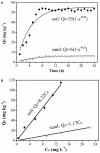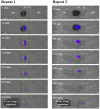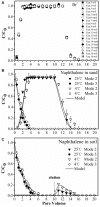Surface-Adsorbed Contaminants Mediate the Importance of Chemotaxis and Haptotaxis for Bacterial Transport Through Soils
- PMID: 32038503
- PMCID: PMC6988784
- DOI: 10.3389/fmicb.2019.02691
Surface-Adsorbed Contaminants Mediate the Importance of Chemotaxis and Haptotaxis for Bacterial Transport Through Soils
Abstract
Chemotaxis and haptotaxis are important biological mechanisms that influence microbial movement toward concentrated chemoattractants in mobile liquids and along immobile surfaces, respectively. This study investigated their coupled effect, as induced by naphthalene (10 mg L-1), on the transport and retention of two pollutant-degrading bacteria, Pseudomonas fluorescens 5RL (Pf5RL) and Pseudomonas stutzeri DQ1 (PsDQ1), in quartz sand and natural soil. The results demonstrated that PsDQ1 was not chemotactic, whereas Pf5RL was chemotactic at 25°C but not at 4°C due to the restricted movement. In a quartz sand column, haptotaxis did not play a role in increasing the transport of Pf5RL as compared with chemotaxis. Compared with a naphthalene-free soil column, Pf5RL broke through naphthalene-presaturated soil columns to reach a stable effluent concentration 0.5 pore volumes earlier due to advective chemotaxis occurring behind the plume front in the bulk solution. Pf5RL also demonstrated greater retention (e.g., a doubled rate of attachment and a one-third smaller breakthrough percentage) due to along-surface haptotaxis and near-surface chemotaxis occurring in less mobile water near the soil surface. However, both chemotaxis and haptotaxis were weakened when Pf5RL co-transported with naphthalene due to reduced adsorption of naphthalene on the soil. This study suggests that surface adsorption of naphthalene can mediate the relative importance of advective chemotaxis (facilitating initial breakthrough), near-surface chemotaxis (increasing bacterial collision), and haptotaxis (increasing bacterial residence time).
Keywords: bacterial transport; chemotaxis; haptotaxis; naphthalene; saturated flow.
Copyright © 2019 Yang, Chen, Zeng, Radosevich, Ripp, Zhuang and Sayler.
Figures






References
LinkOut - more resources
Full Text Sources

